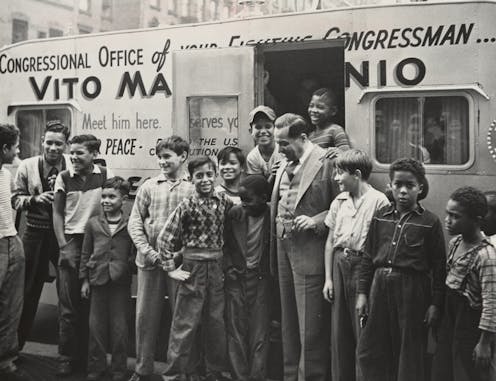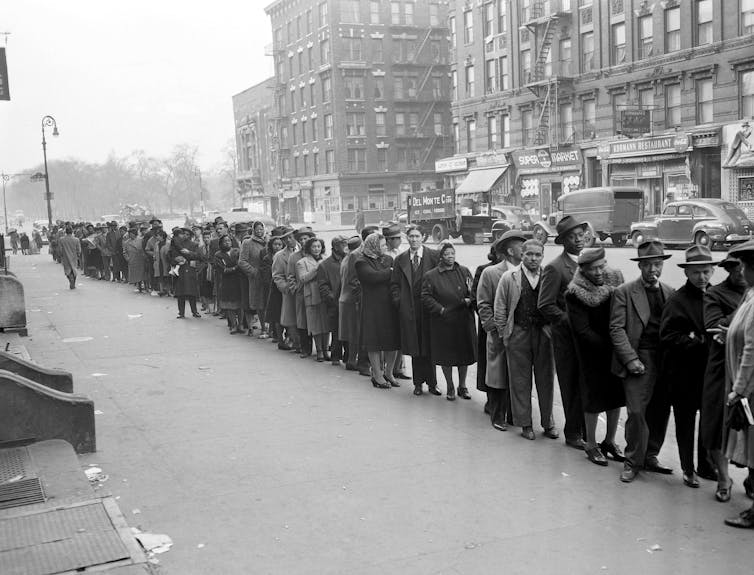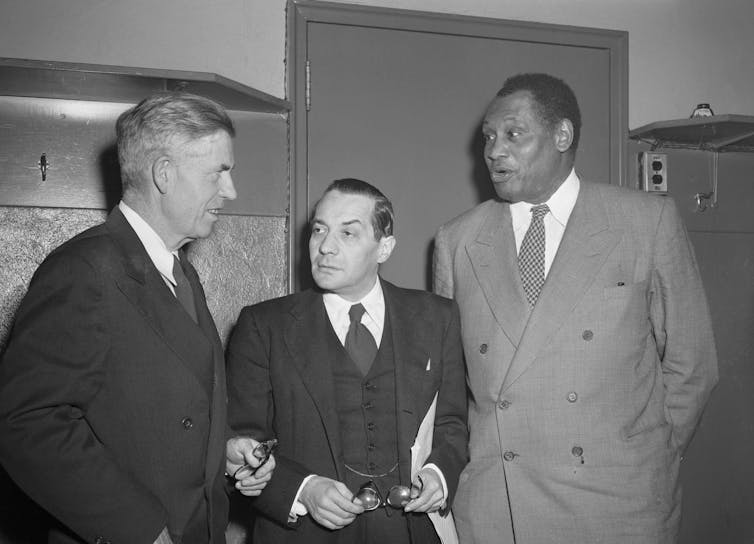Trump attacks diversity, but a fellow New Yorker − US Rep. Vito Marcantonio − worked to represent all Americans in a multiracial democracy
- Written by Sandhya Shukla, Associate Professor of English and American Studies, University of Virginia
 Vito Marcantonio appears in front of his office on First Avenue in New York City in 1948.The New York Public Library Digital Collections
Vito Marcantonio appears in front of his office on First Avenue in New York City in 1948.The New York Public Library Digital CollectionsDonald Trump’s successful presidential campaign presented a dark visionof America that painted migrants as threats to the nation.
Yet his hometown, New York City, is also the birthplace of an alternative political story – one of compassion for ethnic, racial and class differences. And this history offers important lessons for the contemporary United States.
Throughout the 1930s and 1940s, Italian-American U.S. Rep. Vito Marcantonio of New York worked to serve all his constituents in the ethnically and racially diverse section of the northern Manhattan district he represented. He pushed for civil rights for Black Americans and sought to ease immigration restrictions to enable a wide variety of people to enter the U.S. He also called for better working conditions and wages for all.
Marcantonio’s cross-cultural inclinations were about more than mere tolerance or electoral strategy. In my recent book, I explain how Marcantonio, like other notable Harlem figures such as writers Langston Hughes and Claude McKay, practiced what I call “living in difference,” or deeply engaging with those who are unlike you for a shared project.
Living in difference is never free of friction. But it nonetheless models the kind of solidarity that is essential for a multiracial democracy.
Dilemmas of multicultural politics
Marcantonio represented East Harlem for 14 years, from 1934 to 1936 and 1938 to 1950. During his career, he was a nominee of the Republican, Democratic and American Labor parties. And he acted on behalf of an ever-changing mix of Black, Latino and white people.
Marcantonio was always linked with the enclave of Italian Harlem, where he was born in 1902 and lived and worked for all of his 52 years.
But like any urban neighborhood, Italian Harlem was situated in diversely populated environs. Beyond the Italians who began settling in East Harlem in the 1880s and built the era’s largest Italian American community in the U.S., the wider neighborhood contained Jews, Irish, African Americans and West Indians. In the 1940s, when Italians and Jews had already been moving out, Puerto Ricans arrived in large numbers. By 1950, East Harlem would be largely African American and Puerto Rican.
Across Harlem in the early to mid-1900s, there were tensions related to race and ethnicity. Economic and political divides also characterized the period.
The arrival of Puerto Ricans in large numbers into Marcantonio’s East Harlem district provoked tensions.
“They had to get Italians out, so they brought in the Puerto Ricans from Puerto Rico,” a longtime Catholic priest from the neighborhood told me years later.
He didn’t specify who “they” were. But such language and sentiments recall contemporary resentments in today’s multiracial landscape. For people with different languages and citizenship status, sharing space has never been uncontroversial.
Global events sometimes triggered local conflicts in Harlem. In the 1930s, after Italy invaded Ethiopia, fights broke out between Italian Americans and Black residents who protested the invasion in part with a boycott of local Italian businesses.
Children were not exempt from the social forces swirling around them. At Benjamin Franklin High School in East Harlem, efforts at integration had led to a tense atmosphere. In 1945, Marcantonio and the school’s principal, social reformer Leonard Covello, invited Frank Sinatra to sing for students.
The jazz musician Sonny Rollins, then a student at the school, vividly remembered the concert and often spoke about it. Sinatra encouraged understanding and exchange among Black, Italian, Puerto Rican and Jewish students. Soon, the high school had become an example of interracial cooperation for all New York City.
With this complicated backdrop, Marcantonio managed to advocate for everyone in his district.
He communicated in Italian, Yiddish and Spanish. He focused on wages, housing, education and welfare assistance − issues that were as relevant to immigrants as they were to white and Black Americans.
 Voters in East Harlem line up outside a polling place on Fifth Avenue to cast their votes on Nov. 2, 1948.AP Photo/Anthony Camerano
Voters in East Harlem line up outside a polling place on Fifth Avenue to cast their votes on Nov. 2, 1948.AP Photo/Anthony CameranoCross-cultural politics
Sure, there were electoral reasons for broadly appealing to multiple populations. Marcantonio could not win in a diverse district any other way.
But his ecumenical and ethical politics did more than garner votes. It helped create productive dialogues during a period of strained relations among different social groups.
Marcantonio did all this without eschewing his own Italianness. He maintained deep personal connections with those from his community – Marcantonio’s Italian barber spoke at his memorial service – and he closely associated with left-wing Italians in labor unions and other organizations throughout his lifetime.
He also launched public defenses against anti-Italian sentiment, which was rampant. Even in that work, though, Marcantonio never accentuated or mentioned his own whiteness.
Today, with postelectoral analysis so focused on how Democrats lost rural America or fixated on whether racism drove the “white working class” vote, Marcantonio’s career provides another insight: that working-class people and their interests are variegated.
 U.S. Rep. Vito Marcantonio in 1949 with Henry Wallace, left, and Paul Robeson, right, two leftist leaders in U.S. politics.Bettmann via Getty Images
U.S. Rep. Vito Marcantonio in 1949 with Henry Wallace, left, and Paul Robeson, right, two leftist leaders in U.S. politics.Bettmann via Getty ImagesSocial justice
Some of Marcantonio’s most sustained political efforts were for civil rights, both at home in New York and nationwide.
He worked tirelessly, if unsuccessfully, to pass bills in Congress prohibiting discrimination in government defense industries. But those struggles helped lead to a 1941 executive order, issued by Franklin Delano Roosevelt, establishing the Fair Employment Practices Committee, which would enforce equality in business hiring.
He worked with Adam Clayton Powell Jr., a fellow congressional colleague from Harlem, to ban the poll taxes that disenfranchised many Black voters across the South and challenged the segregation of Washington, D.C., public schools.
Marcantonio also joined New York legislators and Communist Party activists in critiquing racism in baseball. When Marcantonio demanded the Commerce Department investigate complaints about the league’s discrimination in hiring, some of his white constituents reacted with vicious disapproval. But Marcantonio persisted, and that battle facilitated Jackie Robinson’s entry into Major League Baseball.
In addition to supporting the Puerto Rican residents of his Harlem district, Marcantonio was an unflinching supporter of Puerto Ricans on the island, too. Puerto Rico struggled throughout the 20th century to obtain basic rights and secure political autonomy. Marcantonio publicly backed that fight, and even supported Puerto Rican independence.
Progressive paths to the future
Marcantonio never disavowed his sympathies for Communist Party-supported causes, even at the height of the Cold War, when paranoia about the threat of communism in the U.S. ran rampant. And, ultimately, Marcantonio was driven out of office in 1950 by U.S. Sen. Joseph McCarthy’s persecution of communists and other governmental figures associated in any way with left-wing causes.
Marcantonio’s fate is a reminder that progressive projects for greater equality in the U.S. often bump up against dangerous forces of retrenchment.
During Marcantonio’s last years in office, the advances in labor rights he had championed through the 1930s and 1940s were undone. In 1947, Congress passed the Taft-Hartley Act, which significantly limited the power and influence of unions.
Though Marcantonio has not become a household name, his legacy lives on in many realms. The “separate but equal” segregation he fought against was outlawed in the Supreme Court’s 1954 Brown v. Board of Education decision, just months before he died. And poll taxes were prohibited in the Voting Rights Act of 1965.
Marcantonio envisioned a progressive path to a more expansive version of America – a country that embraced the rich experience of its heterogeneity. Promoting openness among diversity is not easy, but he spent a lifetime demonstrating why he believed it was a future worth fighting for.
Sandhya Shukla does not work for, consult, own shares in or receive funding from any company or organization that would benefit from this article, and has disclosed no relevant affiliations beyond their academic appointment.
Authors: Sandhya Shukla, Associate Professor of English and American Studies, University of Virginia

